The must-have new guitar effects pedals of 2023
GEAR EXPO 2023: The pedals you need to try this year

- Universal Audio UAFX Del Verb, MAX Compressor and Galaxy '74
- EarthQuaker Devices Aurelius Tri-Chorus
- Electro-Harmonix Lizard Queen
- Walrus Audio Fundamental Series
- Catalinbread STS-88
- Strymon Cloudburst
- Fishman AFX Mini Pedal Collection
- NUX Trident
- J Rockett Archer Select
- Kernom MOHO Magmatic Fuzz Station
- Eventide H90 Harmonizer
GEAR EXPO 2023: We've got everything from acoustic guitar ranges right up to complete guitar rigs in one box as we search out the best guitar pedals arriving this year.
Never has there been a more varied collection of guitar pedals gathered together in one article. We've assembled the latest units based on classic gear (thanks UA), all-new combos (with a nod to Catalinbread), complete stomp rigs (here's looking at you NUX) and even thrown in a new range of acoustic pedals (with thanks to you Fishman).
And where else would you find new Walruses, a Cloudburst, an Earthquake and a Lizard Queen overseeing proceedings? No, not on a new album by King Crimson, but in this, our round-up of the latest new guitar pedals coming to your feet in 2023!
Universal Audio UAFX Del Verb, MAX Compressor and Galaxy '74
This year's NAMM show saw Universal Audio add three effects pedals to its UAFX series and they deliver some of the most iconic effects of all time.
The new UAFX pedals are the Del-Verb Ambience Companion, Galaxy ‘74 Tape Echo and Reverb and Max Preamp & Dual Compressor.
The Del-Verb essentially offers the streamlined highlights of UA's previous Golden Reverberator and Starlight Echo Station pedals in a one-unit solution. It takes three algorithms from each to offer tape echo, analog Bucket Brigade and digital delay alongside spring, plate and hall reverb inspired by classic examples from effects and studio rack history.
On the reverb side, these are the Fender amp-inspired 'golden unit' spring reverb that was also used in the excellent UA Dream '65 amp emulator, plate reverb inspired by the EMT 140 and hall reverb that's a "bit-for-bit" recreation of the Lexicon 224 Digital Reverb from the tail end of the '70s.
Want all the hottest music and gear news, reviews, deals, features and more, direct to your inbox? Sign up here.
Three top-tier sources of reverb on tap there, then.
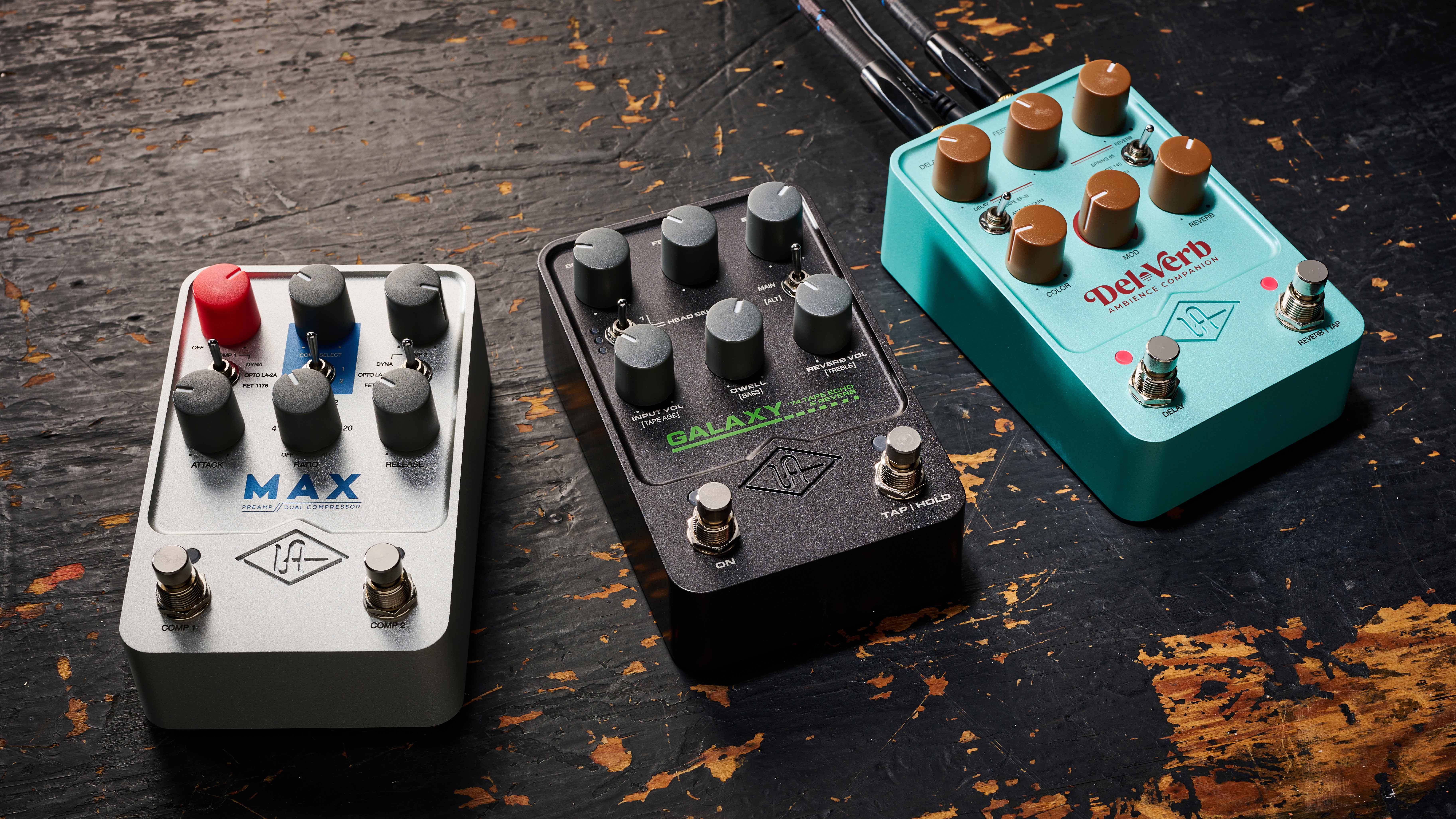
The Galaxy '74 Tape Echo follows the UAD plugin digital recreation of the classic Roland Space Echo. UA is not holding back with this, hailing it as "the most authentic emulation of the classic mid-'70s Roland Space Echo hardware". Quite a claim.
In addition to offering doubled delay times that the original didn't, footswitch options allow players to add tap tempo, adjust real-time effects and customise oscillation sounds via the UAFX Control app.
Finally, the Max Preamp & Dual Compressor is offering some of UA's most popular plugins in pedal form for the very first time. Indeed, the Max could offer the key to elevating your tones to a different level in the studio and beyond with the option of stacked compression.
The proposition is three iconic compressors that have featured on countless classic albums, plus an accurately modeled classic tube preamp: the 1176 Peak Limiter (as featured on UA's recent Volt interfaces too), Teletronix LA-2A, and the 1972 MXR Dyna Comp together, alongside the Solo 610 preamp. And you don't get more iconic names than those in the world of compression.
There's more information at Universal Audio, or purchase from Andertons in the UK for £325 each, $349 at Sweetwater and €379 from Thomann.
EarthQuaker Devices Aurelius Tri-Chorus
Also announced at the NAMM show was EarthQuaker Devices Aurelius Tri-Chorus. It's a compact stompbox inspired by a vintage Boss chorus pedal that offers players three modes of modulation, programmable presets, and the option of control via expression pedal.
The Aurelius takes its cues from a ‘70s Boss CE-1 Chorus Ensemble and presents Vibrato, Chorus and Rotary Chorus models via a three-way toggle switch.
It also promises to be very versatile. Some of its sounds take modulation way, way back – as in back to the 1940s and the Leslie rotating speaker cabinet for a doppler effect and psych sound that really came of age during the swinging ‘60s.
In this Rotary mode, the Width control tackles both the amplitude of the LFO and the width of its pitch modulation. Turn it clockwise to bring out more of those trebly frequencies that would be shooting out of the upper horn, or dial it back to accentuate the woofer in the speaker. The Balance control functions as your wet/dry mix when in Rotary mode.

Mode C, aka Chorus Mode, is a blend of chorus and flanger, and is warmer and slower than the vibrato. If you want the flanger qualities to be more pronounced, simply turn that Width dial past noon and watch it go. In this mode, Balance adjusts the level of the modulated signal, so turn it up for more extreme effects.
Finally, the Vibrato mode is a traditional chorus that uses a triangle LFO to skew the effect towards vibrato. Dial the Balance all the way back and you get a pitch vibrato. Otherwise it works as a wet/dry mix.
The Aurelius Tri-Chorus has top-mounted jacks, is handmade in Akron, Ohio, and is priced £225 / $199. For more details, head over to EarthQuaker Devices.
Electro-Harmonix Lizard Queen
The Lizard Queen has had a very unusual birth as a fuzz pedal, even by Electro-Harmonix standards. The pedal first surfaced as a a design by Josh Scott of JHS Pedals in an episode of the JHS Show on YouTube. His mission statement: design a pedal to look, feel and sound like a missing link for Electro-Harmonix's history. Now it's just been announced as a production model in the EHX catalogue.
"The nano-sized pedal is the vintage EHX octave fuzz that never was but now is!" says the New York company.
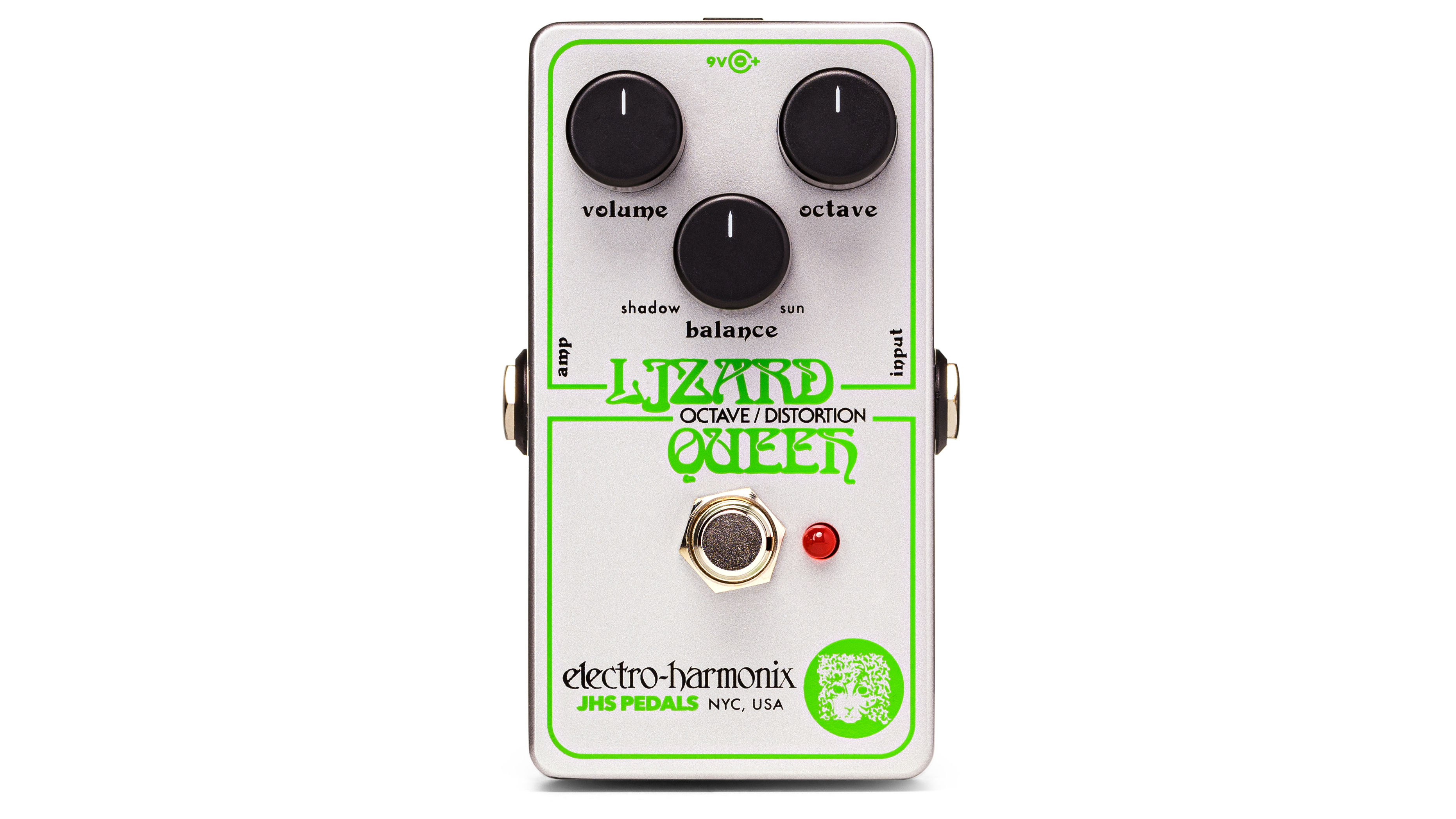
The final version is a smaller nano production model of Scott's '70s-style big box original featuring Daniel Danger's graphic design and the JHS man's circuit design.
The pedal has an octave control for you to blend in as much as you want, and a 'shadow' and 'sun' Balance control that veers between smooth and raspy.
The Lizard Queen is $99 and you can head to ehx.com to find out more.
Walrus Audio Fundamental Series
Walrus Audio's new Fundamental pedal series includes by far the most affordable pedals the US company has been able to offer players.
"For this series, Walrus challenged themselves to design a set of pedals with the tonal integrity that’s required to live on a professional’s pedalboard," says the company, "but with simplified controls friendly enough for even the newest effect pedal users."
Each pedal has three sliders for core control parameters and a three-way switch for changing modes. While the input and output jacks are top-mounted, the 9V power input is on the left-hand side of each pedal.
Let's take a whirlwind tour.
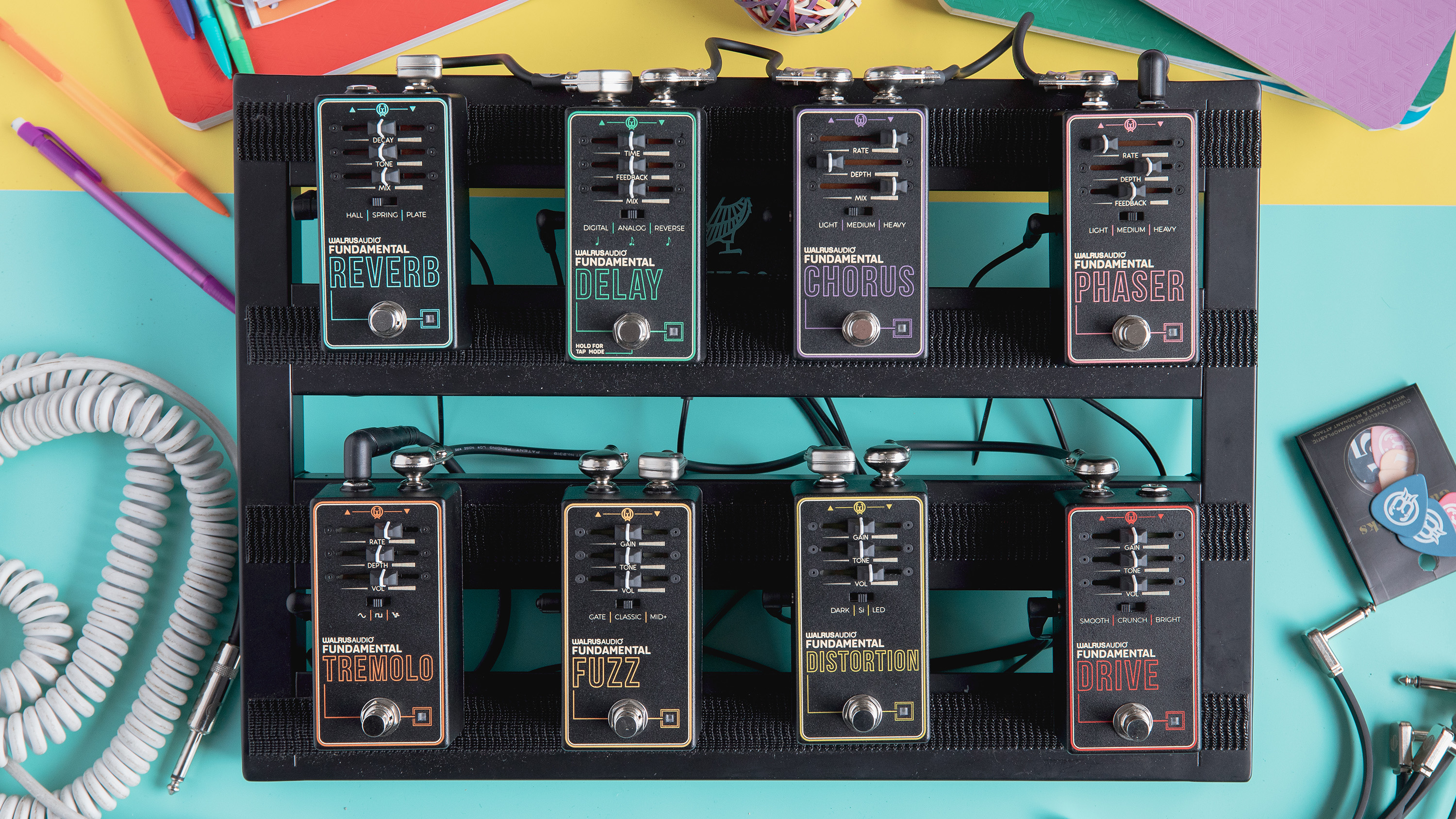
Fundamental Drive (£95 / $99 / €109) is an overdrive with Smooth, Crunch and Bright modes with slider controls for Gain, Tone and Volume.
Fundamental Distortion (£95 / $99 /€109) can, says Walrus, cover everything from "dark and doom through sharp cutting leads" and there's Dark, Silicon and LED modes to get you there. Again, slider controls are for Gain, Tone and Volume.
Fundamental Fuzz (£95 / $99 / €109) is an "aggressive fuzz pedal with a wide tonal range", with Gate, Classic and Mid+ modes. Walrus is encouraging players to experiment with positioning before and after drives in your signal chain.
Fundamental Tremolo (£123 / $129 / €145) is a classic optical tremolo for "iconic chewy movement" – sounds tasty! There's three waveforms to choose from with Sine, Rectangle and Random. We're expecting that latter one to get pretty glitchy. Slider controls here are for Rate, Depth and Volume.
Fundamental Chorus (£125 / $129 €145) is a digital emulation of classic Bucket Brigade territory, with Light, Medium and Heavy modes keeping things simple. The controls here are Rate, Depth and Mix.
Fundamental Phaser (£125 / $129 / €145) is "a versatile digital emulation of a classic phaser". There are three types of phaser algorithms to choose from to make the versatility easy to tap into with Light, Medium and Heavy modes, just like the Chorus. Slider controls are Rate, Depth and Feedback.
Fundamental Delay (£125 / $129 / €145) has three algorithms that could make it the only delay pedal you'll need. Digital, Analog and Reverse modes will help you cover a wide territory of trails with Time, Feedback and Mix controls covering the essential parameters, and there's tap tempo too.
Last but certainly not least, Fundamental Reverb (£125 / $129 / €145) has Hall, Spring and Plate algorithms hopefully fulfilling all classic needs. This should make a nice companion to some of Walrus's more ambient offerings such as the Slötvå and Lore. Parameters here should come as no surprise: Decay, Tone and Mix.
The Fundamental Series pedals are available to buy now from Andertons and Sweetwater. More info at Walrus Audio.
Catalinbread STS-88
Catalinbread's STS-88 Flanger/Reverb is a pedal borne out of an obsession with the flanger that draws inspiration from classic units to design a core effect, before it is given a unique spin by way of an expansive reverb.
It is, says Catalinbread, “a love letter to the flanger” and describes the R&D process as a “one late night frenzy of pedal swapping”.
Catalinbread arrived at its epiphany after plugging a flanger into a reverb pedal. Not just any reverb, but a “cavernous” reverb that staked out new territory for the effect. And so it came to pass, the STS-88 would be a Flanger/Reverb.



Its design is quintessential Catalinbread, with a four-knob enclosure and some cool artwork. The sounds the STS-88 is designed for can be musically unobtrusive and subtle or huge and ambient, but dialling them in looks a breeze.
There is a Depth knob that controls the amplitude of the LFO. Turn it clockwise and the modulated swell of flanger will get deeper and, in certain contexts, more intense.
The Rate knob, meanwhile, controls the speed of the LFO, with a range that extends from a super-slow 0.077Hz to a hectic 6Hz when maxed out.
The Mix knob controls the wet/dry mix, either for subtle textures and ambience or, at the other extreme, more psychedelic escapades.
Finally, the Reverb dial controls the length of the reverb tails, and how big you want it to be. Set this fully counterclockwise and the STS-88 behaves like a regular flanger pedal.
The STS-88 Flanger/Reverb can be run on 9 to 18V DC from a pedalboard power supply, and it draws a minimum of 100mA. It’s priced $172.74 / £199 and available now. See Catalinbread for more details.
Strymon Cloudburst
Strymon products are pricey but often prove to be a long-term investment for players. And Strymon’s reverb pedals probably typify this quality/payoff relationship best.
The big daddy BigSky and medium BlueSky are now joined by Cloudburst. It takes one of the BigSky’s modes (Cloud) and adds the Ensemble algorithm that is new to a Strymon pedal. Doesn’t sound like a lot for your $279, does it? But it is…
The metallic blue finish of the anodised aluminium casing instantly identifies the Cloudburst as part of the BlueSky and BigSky reverb family, and its tie with the latter is especially strong. It's named after one of its modes after all. Is it the same?
Strymon describes it as an "expanded" version and that translates as more sonic versatility for your playing needs. Cloudburst could certainly serve as your only reverb or an excellent second source if you're happy to engage with its impressively scoped controls between songs.
The Cloudburst really is a joy to explore with headphones on a quiet evening, but in Ensemble mode it takes on a whole new meaning. There are two modes to choose from with Mezzo Piano (MP) and Forte. The first adds a subtle bed beneath the reverb signal, while the Forte is capable of swelling synth string ensemble beds.
The obvious applications here are players looking to simulate synth sounds, and this thing can go full Vangelis. But what's interesting is both how much it varies on the input instrument and just how well it follows chord voicings.

The Freeze and Infinite modes, plus the option to access a preset, all require Strymon's $49 Mini Switch. Infinite mode means anything you play after activating it will also be added to the infinite pad sound. In Freeze you can play over your pad sound with a dry tone (or effected with anything placed before the Cloudburst in the signal chain).
Both would be useful to have, but the chance to call up a preset is even more essential here with the distinct offerings of room to ambient reverb with Ensemble. None of which can be done out of the box. For a $279 reverb pedal, we have mixed feelings about that. And yet, the quality of the tones in the stock offering is so high, many players will accept it and still feel that they have a pedal with sounds no other one-unit proposition can deliver right now. And we'd be among them.
Believe the hype. The compact Cloudburst sounds immense, but it can also do subtle. Its dynamic sensitivity reflects the expertise Strymon has built its reputation on and although it comes at a price, you could easily fall in love with the sweeping sounds of this modern classic reverb.
Strymon Cloudburst costs £279/€319/$279. You can read our full review here or get more info from the Strymon website.
Fishman AFX Mini Pedal Collection
Now for a set of pedals aimed at acoustic guitarists. The AFX Mini Pedal Collection is a set of four new pedals that work in parallel with your acoustic guitar sound, so help emphasise parts of its character rather than totally changing its overall tone.
The four pedals are as follows:
The AFX Pro EQ Mini helps shape your acoustic guitar sound with four simple slider controls for Bass, Mid, Treble and Brilliance. A Low Cut fader reduces bass response and feedback, which is also controlled with an additional Phase switch.
The AFX Broken Record Mini is probably the simplest looping pedal you can imagine, with just one button allowing you to record an up to six-minute loop of your playing to get maximum Ed Sheeran should you wish. One neat feature is that you can also load a .WAV file in from your computer to have an instant accompaniment.
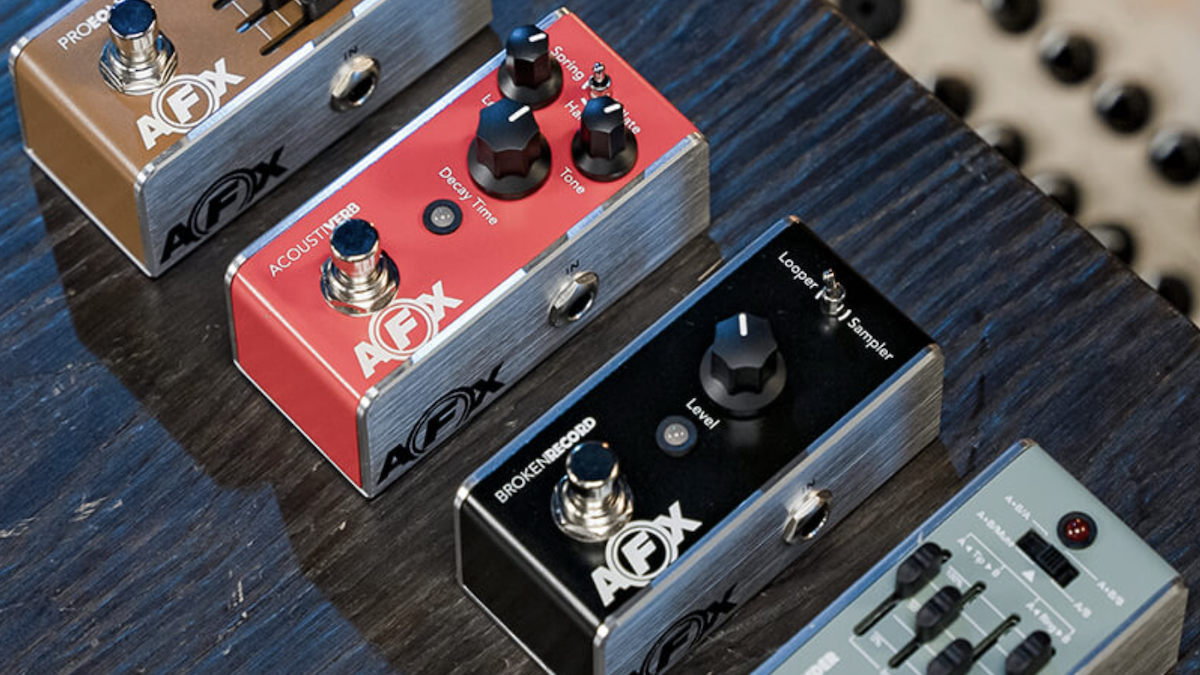
Next up, AFX Acoustiverb Mini has three reverbs built in: Hall, Plate and Spring. The Time knob effectively controls the size of the room - how long the reverb effect lasts - while the Tone knob only adjusts that of the effected sound, not the direct acoustic sound.
Finally AFX Pocket Blender Mini is a 2-channel mixer that can be used to blend two different pickup signals from one guitar, or to switch between a single input from two different instruments. Or just use it as a simple clean booster for your guitar.
AFX Pocket Blender Mini is the cheapest of the new range at $89.95 while the other three all cost $119.95. There's more information at the Fishman website.
NUX Trident
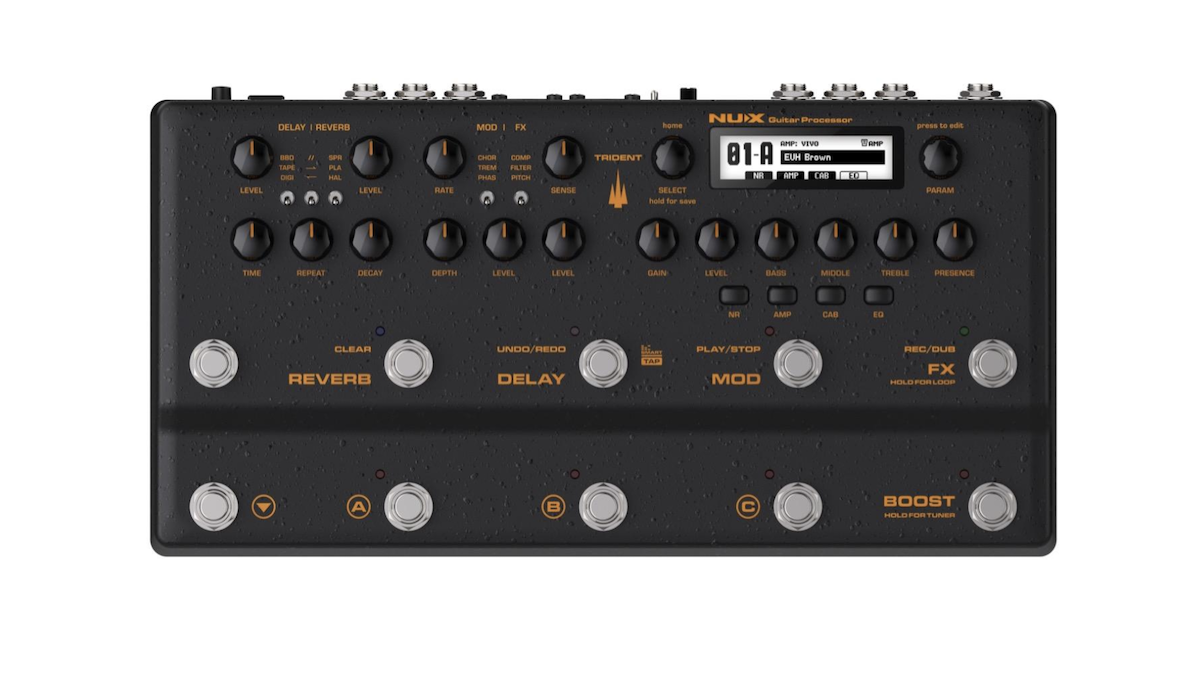
The NUX Trident is an all-new effects pedalboard that features modelling of 27 different amps, a looper and a lot more. In fact you could look at it as an entire rig in one sturdy unit.
NUX says Trident is equally at home on stage and used as a live performance board, as it is in the studio where it can double as a USB audio interface.
Trident features four main stomp-style switches to engage or disengage the main effects plus clear navigation to select further effects and parameters.
The main draw with Trident has to be its amp modelling. It uses NUX's 'TSAC-4K White-box Physical Modeling algorithm' - double the power of that used previously. On board, Trident has two main DSPs, one to handle this modelling and one for the main effects.
The modelling goes as far as to emulate high/low inputs for each amp, with four inputs for each, and everything controllable by the footswitches on the board which also include Gain, Level, EQ and Presence controls.
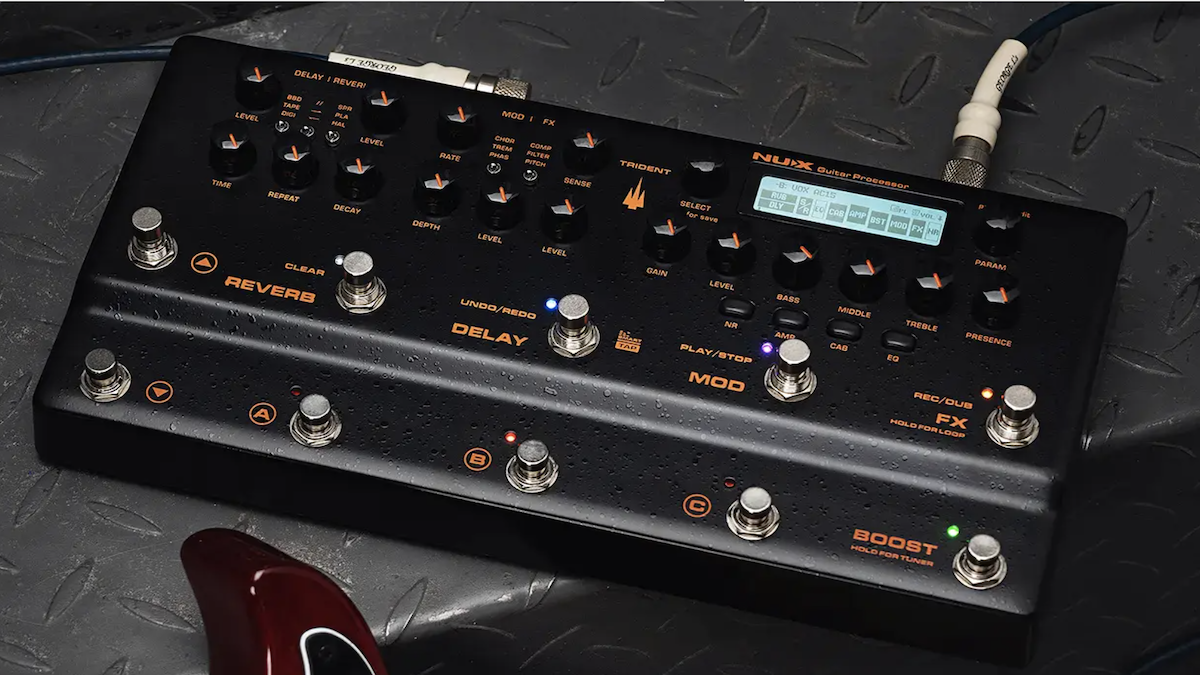
Trident works with an additional software Trident Editor that gives you access to tweak the 27 amp emulations and add further third party Impulse Responses.
You can also use this to help set the device up with your USB routing when using Trident as a USB audio interface. It's easy to configure it so you can record directly into your DAW, for example.
NUX Trident is expected to sell for $450 and there's more – although not that much more – information at the NUX website.
J Rockett Archer Select
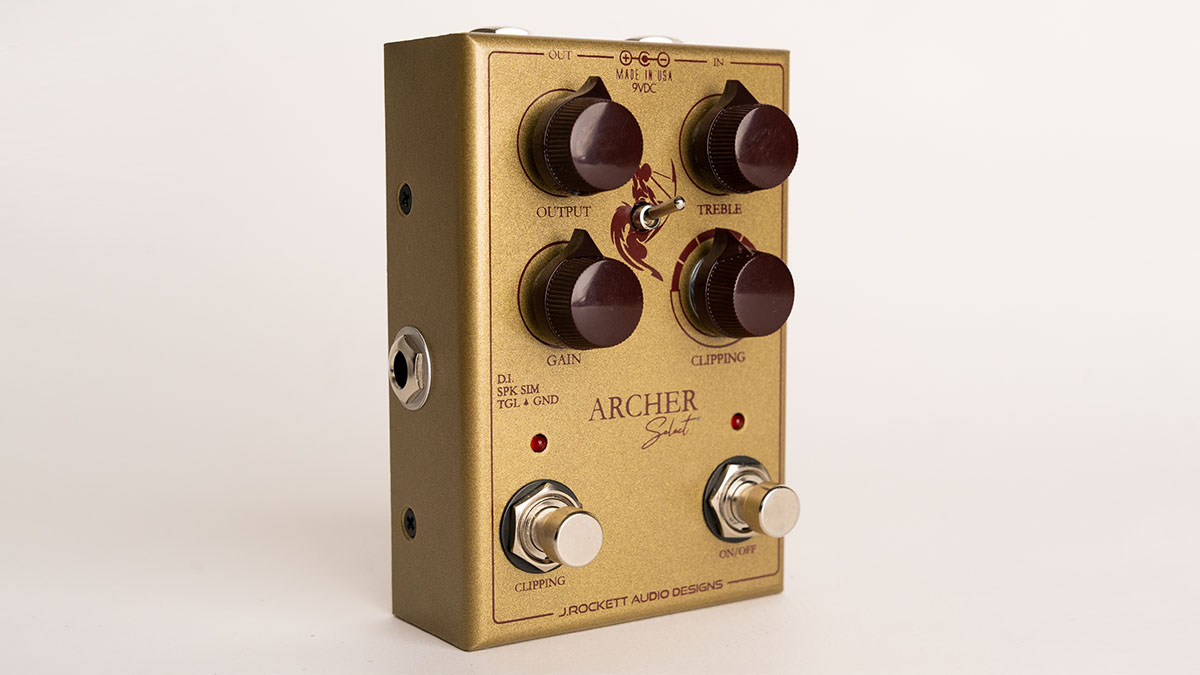
The J Rockett Audio Designs Archer Select is a premium boost/overdrive pedal that offers the choice of seven different clipping options.
As drive pedals go, this is a grand design, a stompbox whose evolution could only be driven by the mythos surrounding the legendary Klon Centaur, and the variant tonal qualities of the NOS germanium diode.
Here, J Rockett splits the difference and gives players the chance they have been waiting for, to cycle through various NOS germanium diodes to replicate their favourite K-style sound - the Centaur "transparent" drive tone that is one of the latter-day bench marks for electric guitar sound.
“Over the years of K-style pedals, people have sworn by the influence of the proper NOS germanium clipping diodes in order for this particular design to be accurate to the original,” said J Rockett. “There is so much speculation on the internet and certainly misleading information by the original designer. We decided to let your ears be the determining factor and to provide the ability for you to easily switch between seven different clipping diode options!”
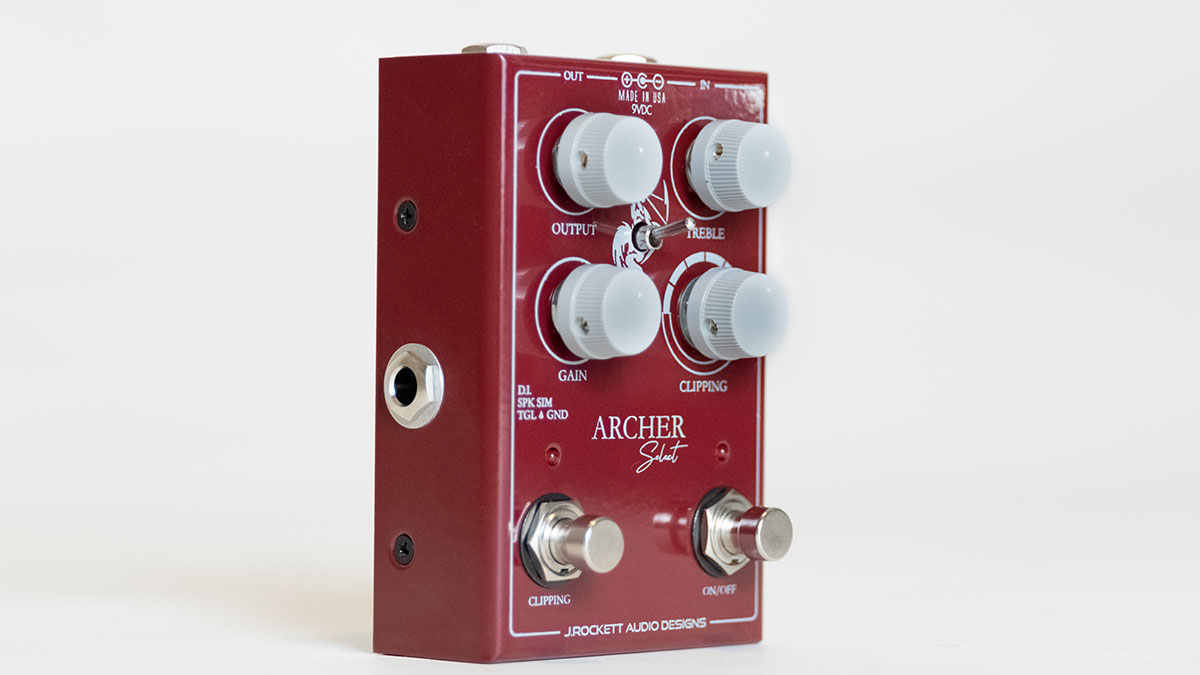
The Archer Select arranges these seven clipping options very cleverly indeed, with a dual-footswitch design to engage the extra clipping options. There is a default clipping mode, in which the stock OA10 is driving the bus.
Stamp on the Clipping footswitch and it engages the alternative clipping options, all six of which are accessed via an oxblood-coloured rotary knob. The other footswitch bypasses/engages the effect.
Choose from 1N270, 1N695, 1N34A, D9B, D9E and Red LED clipping. A red LED illuminates above the Clipping footswitch to let you know when the section is active.
The Archer Select measures 4.25” by 2.75” x 1.25”, so it is more compact than some Klon clones. Its instrument jacks are located on the top of the unit, with the 1/4” DI output on the side.
The enclosure is heavy-duty steel, finished in that champagne gold colour. The Archer Select takes a 9V DC from your pedalboard power supply, and it is available now, priced £349 / €399 / $329. See J Rockett Audio Designs for more details.
Kernom MOHO Magmatic Fuzz Station

Kernom's MOHO Magmatic Fuzz Station is billed as the first augmented analogue fuzz in the world. The pedal looks to do for fuzz pedals what the groundbreaking Ridge Augmented Analog Overdrive did for overdrives.
Like its predecessor, the MOHO allows players to radically shape the sound of the pedal using the Mood control, but adds a new Electricity knob. This promises to add an additional layer to guitar tones, spanning “octaves to strange harmonics with ring modulation” for everything from psychedelia to synth-like textures.
Echoing the Ridge, Post Tone and Pre Tone controls allow for fine-tuning of the pedal’s EQ response, which should ensure optimal interaction with your guitar and amp.
Other features include one footswitchable preset, 128 MIDI presets and an expression input. Kernom also highlights the fact that the tonally analogue MOHO sounds the same whatever the temperature and can go anywhere in your signal chain – welcome news for fans of finicky germanium fuzzes.
The MOHO is available from July 2023 for €349 (approx $390). Head over to Kernom’s dedicated MOHO site for more info.
Eventide H90 Harmonizer
The H9 from Eventide has become a ubiquitous part of many a live and studio setup with performers and producers of all disciplines. And at nearly 10 years old, it’s time for a successor, the H90 Harmonizer.
Ok, this isn’t a true replacement for the trusty H9, just a bigger, better alternative. The H90 is built around the latest ARM-based architecture that is derived from Eventide’s flagship H9000 rack FX unit.
On first look, the improvements over the H9 are obvious: a bigger screen, more controls and foot switches; greater I/O and routing flexibility. And that’s just to the naked eye. These improvements are only possible due to the tech that lies within the unit.
On further inspection, you’ll notice that this box is running not one, but two algorithms simultaneously. Better still, with the very flexible routing options and generous I/O, this multi-effects unit will thrive in any situation you wish to throw at it.
The H90’s signal can be routed in series or parallel and a there's a Dual mode for processing two stereo signals at once. With a guitar setup, you can simply run it in a basic effects pedal chain, or use the four-cable method. You can also route your own effects either as two mono inserts or one stereo insert and even output to multiple amps. With Dual mode, the H90 can operate as a pre/post preamp, or be deployed as dual effects inserts in your DAW.

Eventide’s rich history of effects is on full display here, some old, some new, and playing with two algorithms simultaneously opens up a world of possibilities in sound-mangling.
You’ll find some algorithms work better in certain situations than others, but that’s just the tip of the iceberg and finding out is half the fun. The amount of options here is staggering and certainly adds to the value of a pedal, which let’s face it, is probably not on a lot of people’s shopping lists due to its lofty price. However, it blows its smaller brother out of the water in every way, so we feel the price tag is more than justified.
Eventide rightly calls the H90 an ‘inspiration engine’; it takes you on a journey through time and space, and who knows where you’ll end up? It promises inspiration and delivers it in spades; keeps you entertained for days.
The H90 Harmonizer costs £999. You can read our full review here or get more information from the Eventide website.
Looking for more great new gear? Get all our round-up, news, features, tutorials, tips and more at our Gear Expo hub page.
Andy has been writing about music production and technology for 30 years having started out on Music Technology magazine back in 1992. He has edited the magazines Future Music, Keyboard Review, MusicTech and Computer Music, which he helped launch back in 1998. He owns way too many synthesizers.


